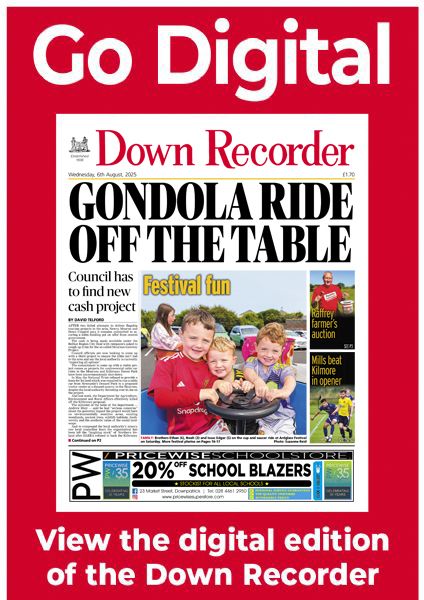Detective work unearths details of lost cross
Detective work unearths details of lost cross
16 July 2014
HUNDREDS of thousands of people have walked past three large granite stones sitting just inside the entrance to Down Cathedral over the decades.
Many may have passed only a cursory glance at the stones en route to the inner sanctums of the historic church, blissfully unaware these large pieces of granite are of extremely significant archaeological and historic importance.
It is believed the stones once formed part of not only one of Ireland’s most ancient high crosses, but was located at the reputed burial site of St. Patrick himself.
And, if ambitious plans come to fruition and funding can be secured, St. Patrick’s Cross could be recreated using the three surviving granite stones and positioned at the graveside of Ireland’s patron saint.
Plans to recreate the former cross were boosted recently following a discovery by Carrickfergus man George Rutherford.
He came across long-forgotten sketches, tucked away in a Victorian scrapbook in the Public Records Office of Northern Ireland, which has provided vital clues which will allow experts at Down County Museum to piece together the remains of what could be one of the most ancient High Crosses in Ireland.
The pieces of a complex archaeological jigsaw are now being assembled to reveal the true image of the 1,200 year-old, four metre tall High Cross of Mourne granite which once stood sentinel at the traditional site of St Patrick’s Grave on the Hill of Down.
Fragments of the cross have long puzzled experts but, following the restoration of the Downpatrick High Cross earlier this year and in anticipation of a major extension to the Down County Museum, its curator, Dr. Mike King and his colleagues, focused attention on the mystery of the ancient St. Patrick’s Cross.
The Curator began to search for early images of the cross and coincidentally, Mr. Rutherford arrived at the museum with the news that he had found a drawing of the St. Patrick’s Cross, dating back to 1843 in a scrapbook of sketches by Alexander Johns of Carrickfergus.
And, by another happy coincidence, Peter Harbison — an expert on Irish High Crosses — identified another drawing of the Cross, dating around 1840, amongst a collection of drawings put up for sale in Dublin which have subsequently been purchased by the Down Council-owned museum.
Dr. King said that together, the old drawings give vital clues to the original appearance of the cross and trace its more recent history.
“They show that the Cross had been damaged some time before 1840, losing its cross-shaft, and having its top arm knocked off,” he explained.
“It was also the subject of vandalism in 1842, and although re-erected several times, it was eventually broken into the three sections which survive inside the entrance of Down Cathedral today.”
Armed with the “blueprint” of those drawings, the Museum enlisted the generous support of Dean Henry Hull, the Friends of the Museum and the Downe and Lecale Historical Society to have the surviving fragments of the Cross conserved by Cliveden Conservation, the experts responsible for conserving the original Downpatrick High Cross earlier this year.
The cleaning revealed intricate interlace, key and spiral patterns on the fragments which could predate the Downpatrick High Cross by 100 years, and make St. Patrick’s Cross one of the earliest High Crosses in Ireland.
The Museum has now commissioned archaeological reconstruction artist, Philip Armstrong, to create initial drawings of what St Patrick’s Cross may have looked like. It’s believed the cross may have stood over four metres tall, with the cross-head 1.6m wide and was not supported by a ring.
Experts suggest this may have made it particularly vulnerable to damage, and was probably one reason why the later High Crosses of about 900 AD were carved with the characteristic ring around the cross-head.
St. Patrick’s Cross appears to be an early prototype cross, perhaps like the smaller ring-less Kilbroney Cross, influenced by early High Crosses made from wood and without the later figure sculpture in relief found on the ure Crosses.
Dr. King said now that the importance of the St. Patrick’s Cross is being recognised and its original image is emerging, it may be possible to scan the fragments and recreate the entire cross from the remains and drawings that survive, creating a replica of the Cross to stand at St. Patrick’s Grave, where the original was a focus of veneration until the 1840s.
Down Museum will be including a visit to the newly conserved St. Patrick’s Cross during its Medieval Mystery Tours taking place on Sunday afternoons between 2pm and 5pm, on July 20 and 27 July and August 3, 10, 24 and 31.
Tickets cost £7 for adults, £4.50 for under 16s, £20 for two adults and two U-16s. The concessionary charge is £5, with places available by pre-booking from the Down County Museum, telephone (028) 4461 5218.


